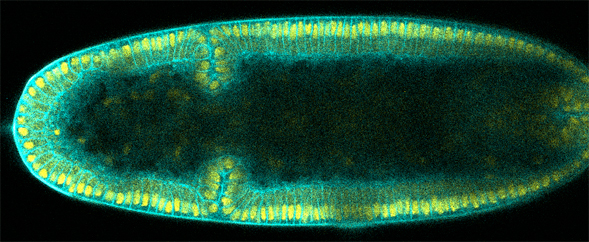
News and Announcements from the CDB
Yu-Chiun Wang, team leader of the Laboratory for Epithelial Morphogenesis, and his team of international collaborators were named one of the recipients of the prestigious and highly competitive 2015 Human Frontier Science Program (HFSP) Young Investigator Grants for their proposal, “Adaptive function and evolutionary capacity for a transitory epithelial structure.”
The grant, worth 1.05 million US dollars, will be divided among the three laboratories to fund their project that aims to understand the mechanisms and functional significance of a transient epithelial structure that forms during the early development of Drosophila (fruit fly) called, the cephalic furrow. The cephalic furrow appears as a groove in the epithelial tissue of the embryo during the gastrulation stage, demarcating the future head region from the trunk region. But, it eventually disappears without contributing to the formation of an organ or other body parts in the adult fly. It remains unknown why cells within the tissue go through the trouble of allocating energy to mobilize dramatic shape changes that do not contribute to the formation of a lasting structure. That the formation of this structure is markedly stereotyped and precisely choreographed, however, seems to suggest that it is critical for fly development. Interestingly, the cephalic furrow appears to be a recent invention in an advanced evolutionary lineage within the two-winged insect species, and a comparison of fly species that form or do not form cephalic furrow could reveal the genetic changes that gave rise to this groove-like structure and the mysterious function that it was evolved to perform.

Left to right: Yu-Chiun Wang (RIKEN CDB), Zia Khan (University of Maryland, College Park),
and Steffen Lemke (University of Heidelberg)
Wang’s collaborators includes computer scientist Zia Khan at the University of Maryland, College Park, USA, and evolutionary developmental biologist Steffen Lemke at the University of Heidelberg, Germany. Wang and Lemke will work together on the biological side, using imaging technology to observe cell shape changes as well as analyze and compare genomics data from Drosophila and other non-model fly species to understand the process and the function of cephalic furrow formation; Khan will provide the tools to extract quantitative information from the imaging datasets and also assist in analyzing the genomics data.

Cephalic furrow forming in the early embryo of Drosophila
“Researchers studying early Drosophila development all know about the cephalic furrow, but no one knows how it is formed and its function during development,” says Wang. “An evolutionary angle will help us gain insight into why this structure was evolved and provide a framework to understand the mechanism and function of cephalic furrow formation and other transitory epithelial structures.”
The HFSP is an international program of research support awarded by the International Human Frontier Science Program Organization (HFSPO) based in Strasbourg, France. Its aims are to promote intercontinental collaboration and training in cutting-edge interdisciplinary research in the life sciences. There are two types of research grants offered: Young Investigator Grants for teams of scientists who are all within five years of obtaining their first independent position and Program Grants, which are open to teams of scientists at any stage of their careers. Of the 1013 proposals submitted for the 2015 competition, a total of 10 Young Investigator Grants and 21 Program Grants were awarded.